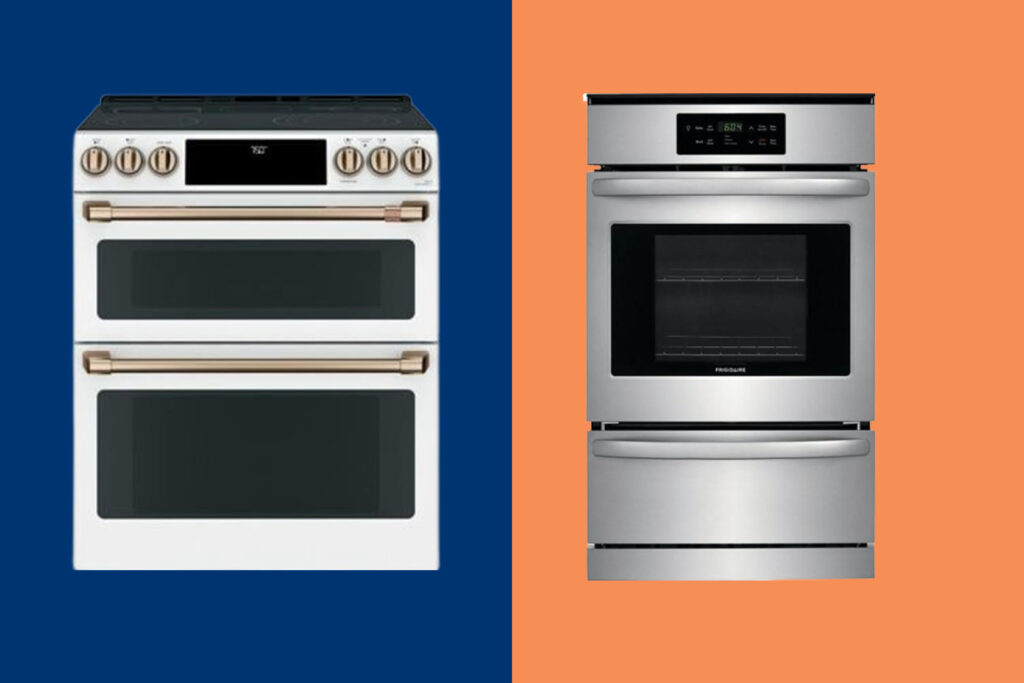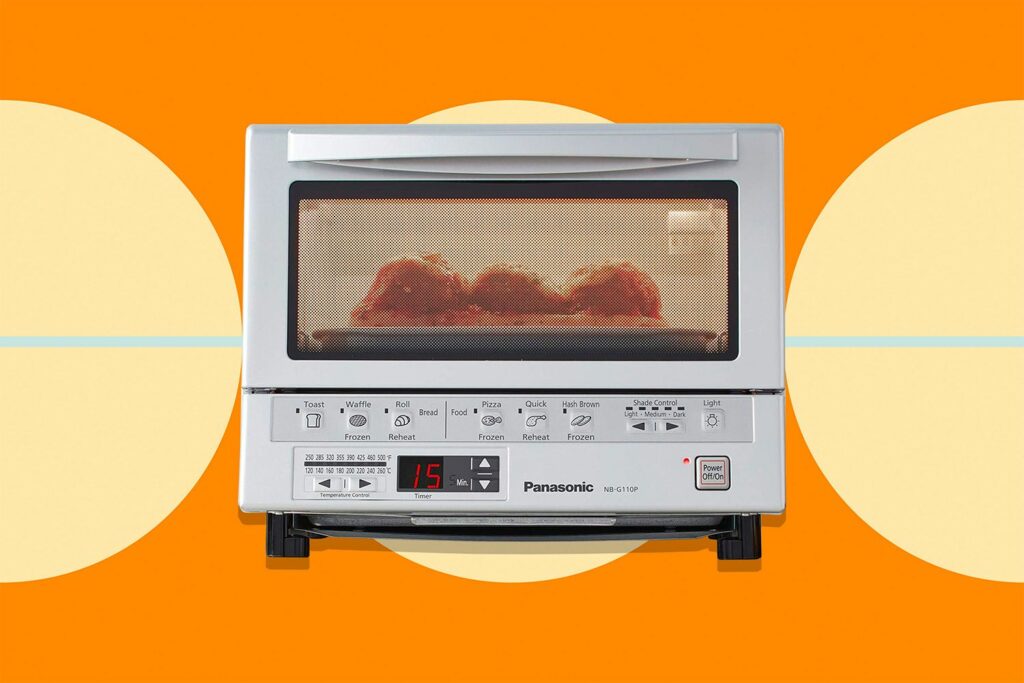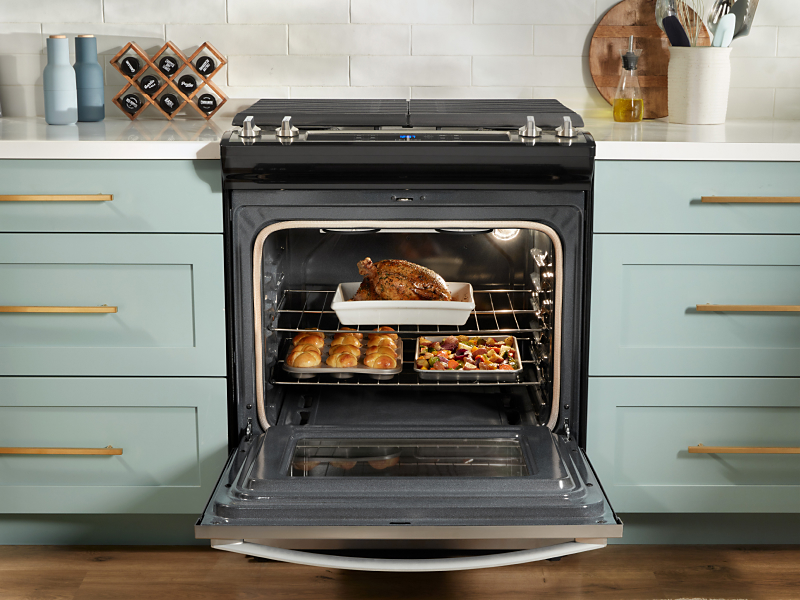Convection oven vs conventional oven; Let’s heat things up!

Ovens have been around us for decades. And due to technological advances, we now have various types of ovens with amazing functions to choose from. Although conventional and convection ovens have similar exteriors, when you look inside, it’s simple to tell the two apart.
The top and bottom of the oven cavity are equipped with heating elements in conventional ovens. In addition to a fan that aids in distributing hot air throughout the oven cavity, convection ovens also feature these components.
This may aid in the uniform baking of items placed on various racks. Some designs incorporate a third heating unit at the cavity’s back.
But that’s not all! Let’s explore all the specifications that each type of oven has to offer!
Convection Oven

A convection oven has a fan and exhaust system. This fan and exhaust system generates hot air inside the oven cavity. It also minimizes hot and cool areas. And promotes a more uniform result while cooking on multiple racks. True Convection, is a third heating element that can be added to convection ovens. This helps meals cook more quickly. By circulating hot air evenly throughout the top, bottom, and sides of your dish. They may cut the need to rotate your dishes in the oven and are perfect for baking and roasting meats.
You need to be aware that recipe times and temperatures might need to be changed. Especially when using a convection oven. The convection oven also comes with a “Convection Conversion” feature. This function allows a few gas and electric convection ovens to perform the calculations. And make the necessary adjustments for you so you don’t have to.
Conventional Oven

There are two heating components in a standard conventional oven. These heating components warm the air inside. The bottom heating element is the main heat source. If you’re all set to roast large chunks of meat, such as whole birds or turkeys, the bottom heating element, which is the main source of heat, is perfect. The upper heating element works best for broiling and browning casseroles. Because it produces a powerful top-down heat. For casseroles and baked items, the “default” location can be the center rack.
As opposed to convection ovens, conventional ovens do not have a fan to circulate hot air. Thus where you set your oven rack is important for good results. You may also need to rotate some dishes from time to time. This is to ensure that whatever you put in the oven cooks evenly.
There are many brands out there that offer a variety of conventional gas and electric ranges. and as well as wall ovens. To complement a separate cooktop.
Conventional Oven Pros
Conventional ovens are sometimes referred to as “Traditional Ovens”. And are generally easier for the ordinary user to use. Simply because they have been around longer than convection ovens. Additionally, the majority of recipes are written for conventional ovens. Making them perfect for novice cooks. Also, conventional ovens aren’t as dry as convection ovens. Which is great for anyone who wishes to preserve the moisture in their meat.
Conventional ovens are typically preferable for baking. Since convection ovens have a tendency to cause baked goods. Particularly those containing yeast, to rise and cook too quickly. In this sense, compared to convection ovens, traditional ovens can bake a wider range of foods. A typical oven will not evenly bake a dense loaf of rye bread or a blueberry pie with a flaky crust.
Last but not least, conventional ovens are usually much less expensive. Than their convection and combination equivalents.
Conventional Oven Cons
Conventional ovens have many benefits. They are also a terrific entry point into the world of essential kitchen appliances. But they also have some disadvantages. Their primary drawback is that they don’t cook as adequately as convection ovens do.
You’ll need to rotate whatever you’re cooking a few times. To guarantee evenness. Because the heating components are on top and bottom of the oven. This is valid for conventional ovens that come equipped with a fan. To “mimic” convection heating. There are no combination ovens that offer both convection and conventional heating components. So those who are interested in one should be aware of this.
Another drawback of conventional ovens is that only one item can be cooked at a time. Mainly due to the risk of burning. If it is placed too close to the heating element on the top or bottom. Cooking many meals further exacerbates the uneven heating in a typical oven. Because there will be pockets of cold and warm air there.
If you’re using a convection oven, your food will cook more quickly and effectively. Than conventional ovens. Conventional ovens tend to require more energy to heat up and cook as well as more time. This makes them less suited for anyone who typically cooks under time pressure. Whether you choose to power your oven with electricity or gas. The savings from choosing not to buy a more expensive convection oven may eventually be offset. By the increasing requirement for gas or energy to run your conventional oven.
Convection Oven Pros
Convection ovens, in general, cook food faster, and more evenly. They also use less energy than their conventional equivalents. Convection ovens can be cost-effective for some people. Even though they are generally more expensive because of the time saved on cooking. And the money saved on gas or electricity.
You don’t need to bother about rotating your food while it cooks. Because convection ovens encircle it with hot air. Compared to conventional ovens, convection ovens are superior in crisping and browning food. There are combo convection ovens that also include a steam function. If you want to spend your money on an oven that can do it all. For combo ovens of superior quality, be prepared to pay more. Convection ovens, , can easily cook several items at once. And are adaptable on their own.
Conventional Oven Cons
Convection ovens are generally more expensive than conventional ovens. As we already discussed above. This greatly increases the entry barrier. Additionally, installing convection ovens could be expensive. And in some cases impossible. Because they need an exhaust vent that goes outside the building.
Since most recipes aren’t intended for convection ovens. Another drawback of convection ovens is that they can be more challenging for some people to use. In fact, it’s possible that you may need to change the recommended cooking time. And also the temperature if you use a convection oven to prevent burning your food.
Convection ovens also have a drawback in that they aren’t quite as effective at baking. As conventional ovens do. You should be aware of this. Especially if you’re using your oven primarily for baking. Rather than for preparing meals.
Finally, because of the fan and exhaust system, convection ovens are noisier. Whereas, conventional ovens are actually quite silent.
Convection Oven vs Conventional Ovens – The Similarities
You might be surprised to hear that a convection oven and a standard oven are nearly identical in terms of the oven’s physical characteristics. Convection ovens actually have an additional function over normal ovens, making them nearly identical to each other. The warm air is distributed uniformly over the cooking area of a convection oven thanks to an additional fan and exhaust system.
A convection oven typically has one source of heat (generally in the bottom of the oven) but additionally offers the option of convection heating, which activates the convection fan system and distributes heat evenly throughout the whole oven.
Which type of oven should you get?
It can be difficult to decide between a convection oven and a regular oven. Thankfully, it’s not as challenging as it first appears. Understanding what you want from your oven, how much you want to spend, and how frequently you will use it are ultimately what matters.
Choose a classic oven that will do the trick without breaking the bank if you’re on a tight budget and don’t plan to use your oven every night or even every week. On the other hand, if you enjoy cooking and are prepared to spend a little more money, a convection oven is a terrific way to get the most out of your oven. By simply turning the fan off, convection ovens can always be used as regular ovens.
So why would you buy a convection oven? “Crispy food” in a nutshell. Everything from roasted potatoes that will make you drool to chicken with crispy skin benefits greatly from convection cooking. Food cooks more quickly and evenly because of the circulating heat, giving it that irresistible, crispy exterior.
Conclusion
The oven is frequently the focal point of the kitchen. And having a high-quality model will match your cooking preferences and talents. They offer accessories and features that can enable you to polish your culinary abilities.
However, if you’re new to the oven market, you could be taken aback by the vast array of models available. Even selecting the size and design of your new oven can be difficult. Let alone selecting the appropriate sort of heating element.
Thankfully, there are only two primary types of ovens. Conventional ovens and convection ovens. We hope that you learnt a thing or two from our guide and are now ready to go hunt for your ideal oven!
Happy baking!
